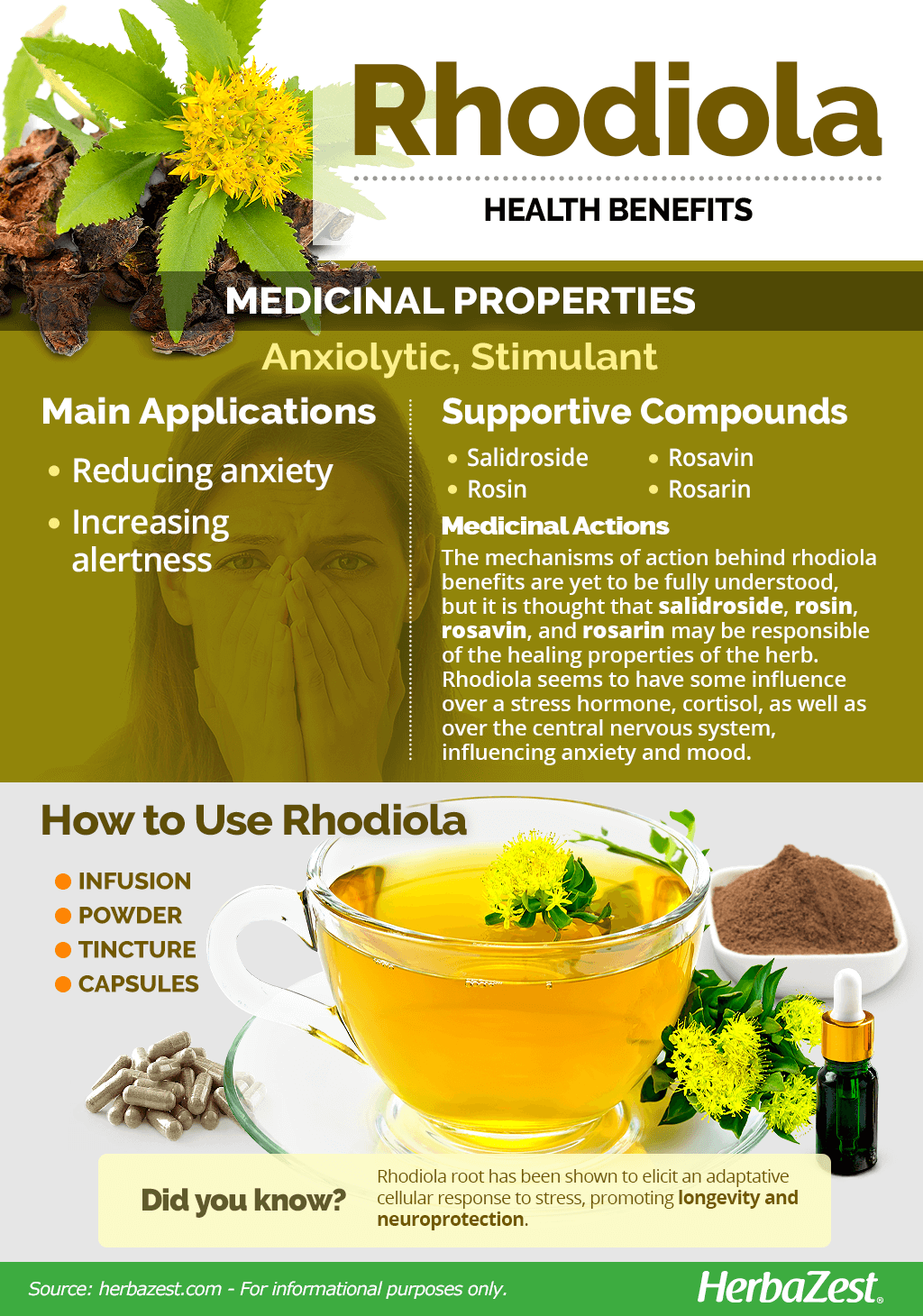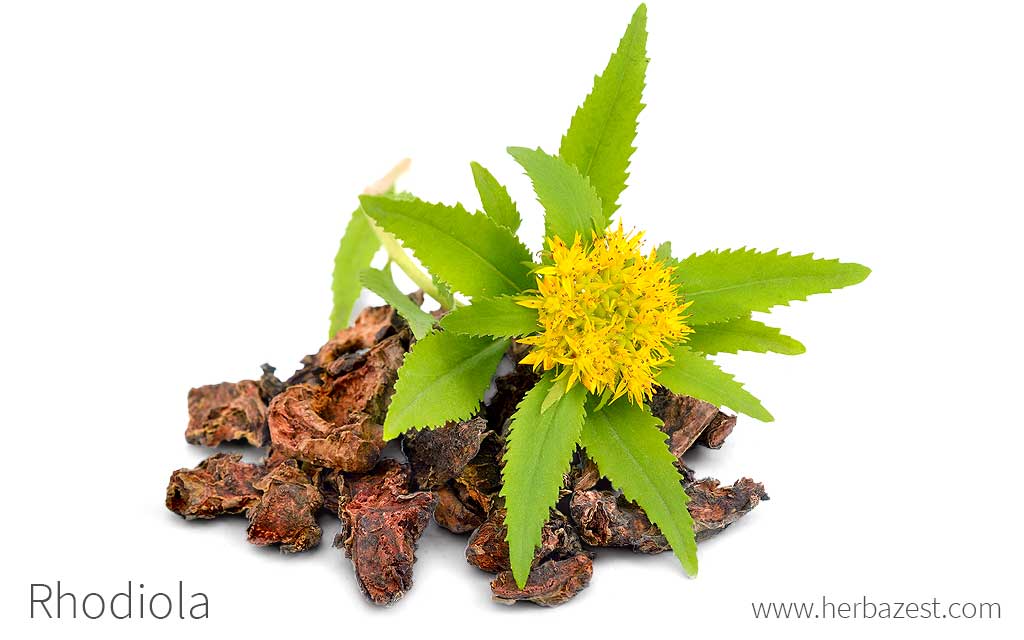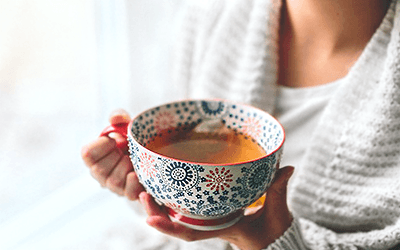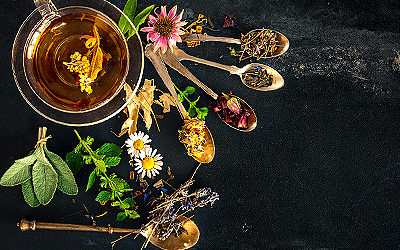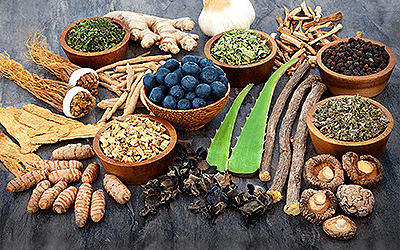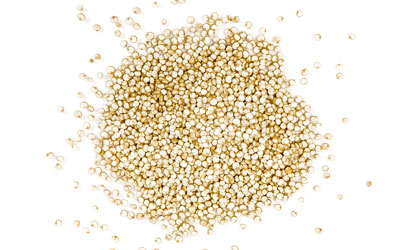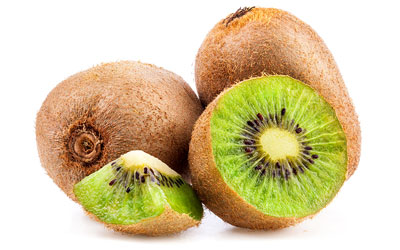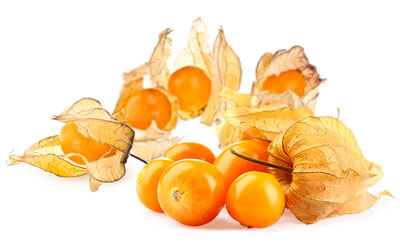Rhodiola is a cold-weather plant that is native to Russia, Scandanavia, and Canada. It has been used as a medicinal plant for thousands of years in these locations, but only recently has the modern Western world begun to learn about the many benefits of rhodiola. Today, it is growing in popularity because of its great potential for use in herbal remedies.
Rhodiola Medicinal Properties
Health Benefits of Rhodiola
Rhodiola is used for many different conditions, but several of these are not supported by scientific research. However, scientific studies have found sufficient evidence that the plant is particularly useful for:
Reducing anxiety. Rhodiola seems to be useful in inducing calmness that can help counter stress, anxiety, and possibly even depression.
Increasing alertness. Research suggests that rhodiola has the ability to help reduce fatigue and produce feelings of wakefulness.
How It Works
While the mechanisms of action behind rhodiola benefits are not completely understood, it is thought that the plant affects the stress hormone, cortisol, as well as the central nervous system1, both of which influence anxiety and mood2,3 as well as alertness. Some compounds that may play a role in this effect are salidroside, rosin, rosavin, and rosarin.
Rhodiola's salidroside has been shown to elicit an adaptative cellular response to stress, medically known as hormesis, that seems to promote longevity and neuroprotection.4
Herbs with similar ansiolytic properties are lemongrass, rosemary, St. John's Wort, and valerian; whereas coffee, cacao, ginseng, and macambo also provide neurostimulant benefits.
Rhodiola Side Effects
Rhodiola appears to be mostly safe, but it is still being investigated. It may cause irritability, insomnia, fatigue, or other unspecified unpleasant sensations, but these are most common with high doses.
Rhodiola Cautions
Rhodiola has no known medical interactions, and it has been proven to be safe to use concurrently with antidepressants. It may cause allergic reactions, which could include symptoms such as a rash or difficulty breathing, and it should not be taken by those who are breastfeeding or pregnant. Additionally, it should be used only with caution by those with bipolar disorder, as it has not been studied extensively in connection with this disorder.
- Medicinal action Anxiolytic, Stimulant
- Key constituents Salidroside, rosin, rosavin, rosarin
- Ways to use Capsules, Hot infusions/tisanes, Tincture, Powder
- Medicinal rating (3) Reasonably useful plant
- Safety ranking Safety undetermined
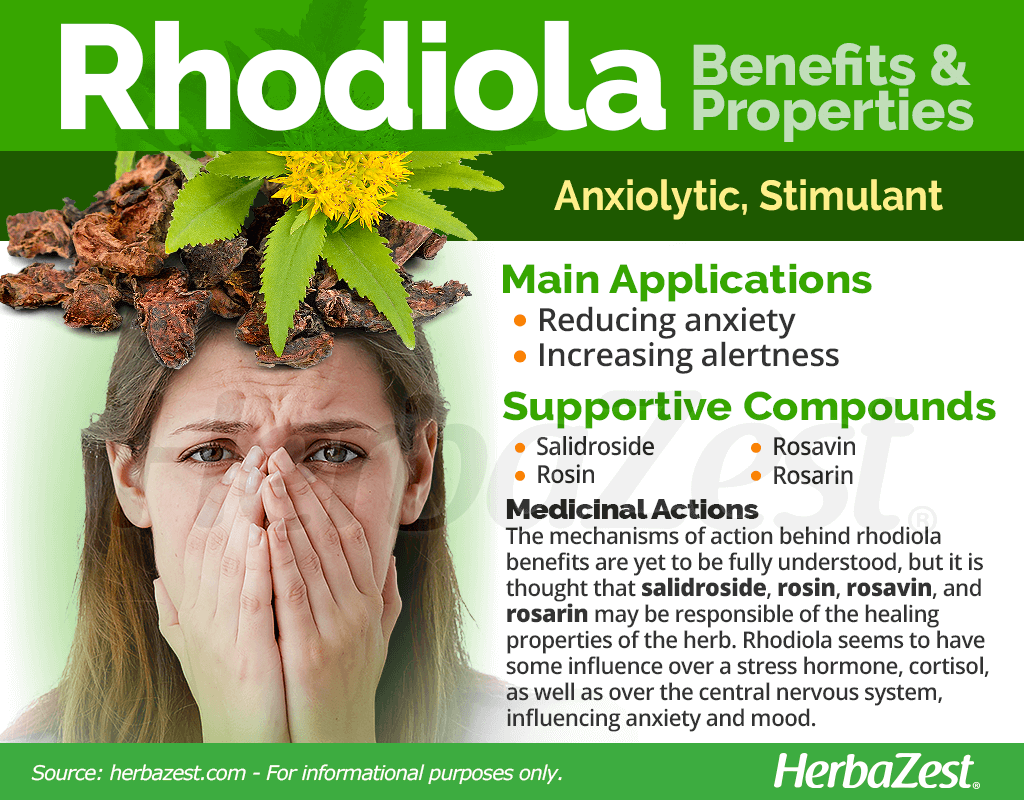
How to Consume Rhodiola
In most Western countries, rhodiola root is used strictly as an herbal supplement. While there are some groups of people who use the plant as ingredients in culinary dishes as well, supplements provide the highest medicinal amounts of the plant and its strongest health benefits.
In China, the leaves of rhodiola are consumed alone and used as an ingredient in various dishes, along the shoots of the plant.
Natural Forms
Infusion. Rhodiola tea can be bought in pre-made tea bags, or it can be made at home with the dried rhodiola root. It is best used to reduce anxiety.
Powder. To enjoy the benefits of rhodiola powder, it should be mixed into other food, such as a smoothie. Powder made from rhodiola can calm feelings of anxiety.
Herbal Remedies & Supplements
Tincture. Rhodiola tincture can be taken alone or mixed into a drink, and can both stimulate the mind and relieve stress.
Capsules. Rhodiola capsules are effective for both relieving anxiety and increasing alertness.
- Edible parts Leaves, Root
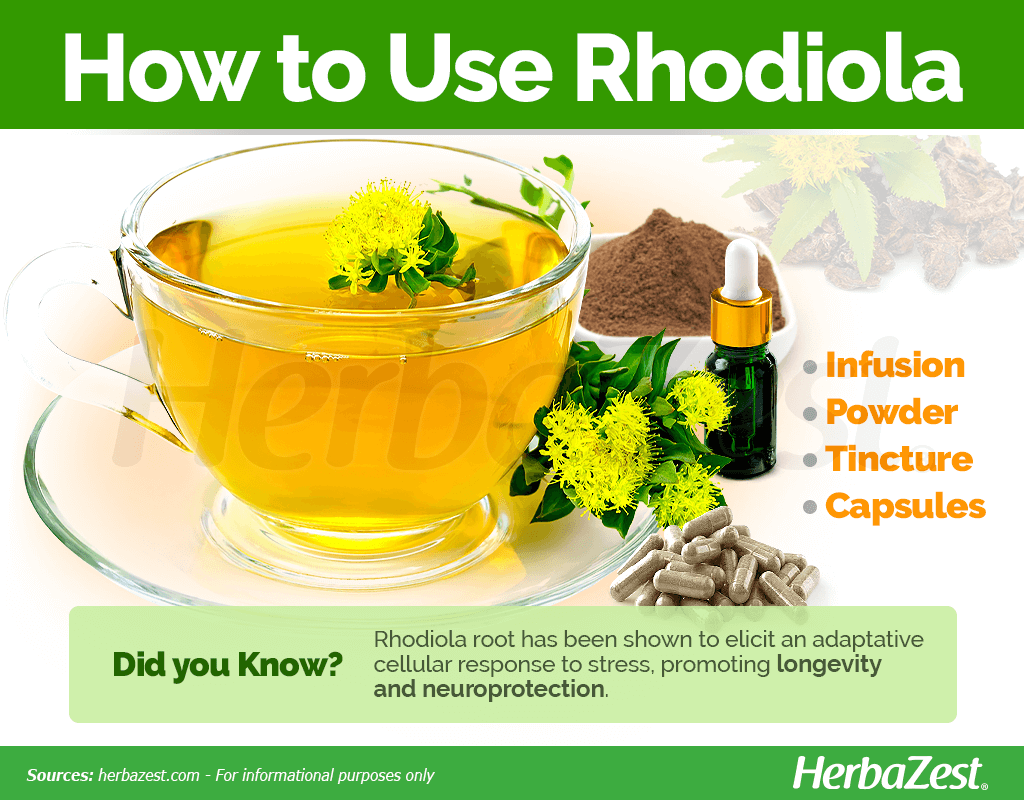
Growing
Rhodiola is not a common choice of garden plant, but with a little effort it can be grown in a garden or backyard and provide its many health benefits.
Growing Guidelines
Rhodiola is propagated by seed or cuttings. If using seeds, they should be stratified, or kept in cold conditions, for six weeks before planting.
Plant rhodiola in fertile, well-drained, sandy loam. It can also grow in rocky soil, but this may decrease the yield.
Seeds should not be buried deeply, as placing them too far beneath the surface level of the soil will affect their ability to germinate.
The ideal temperature for germinating seeds is 50°F (10°C), and germination usually takes two to four weeks at this temperature.
Rhodiola requires full sun, and will not grow in more than partial shade.
The plants should only be sown in the garden after the last frost. Seeds may be planted earlier indoors and transplanted outside when the weather warms.
Young rhodiola seedlings should be watered frequently to keep them moist. Older plants are largely drought resistant, but should still be watered regularly.
Compost is beneficial for the plant, both because of its ability to fertilize and retain moisture.
Rhodiola is able to survive in US hardiness zones 2 - 7, but will not do well in warmer climates.
Weeds can cause many problems for rhodiola plants, which take a long time to develop their root systems, so weeds should be removed as soon as they appear.
Rhodiola has few problems with pests and diseases, but some fungi or weevils may cause damage.
- Life cycle Perennial
- Harvested parts Roots
- Light requirements Full sun
- Soil Light (sandy), Well-drained
- Growing habitat Cool temperate regions
- USDA Plant Hardiness Zones 2a, 2b, 3a, 3b, 4a, 4b, 5a, 5b, 6a, 6b, 7a, 7b
- Pre-germination seed treatment Stratification
- Planting time Spring, Right after last frost
- Potential diseases Fungi
Additional Information
Plant Biology
Rhodiola is a perennial succulent that can grow to heights of one foot (30 cm). Its spread can also reach one foot (30 cm). Its leaves are light green, and it is flowers can range from yellow to orange.
Rhodiola may also be called arctic root, golden root, or rose root.
Classification
Rhodiola is scientifically classified as Rhodiola rosea, and belongs to the Crassulaceae family, also known as the stonecrop or orpine family. Like the rhodiola plant, many species that belong to this family have succulent leaves, but none are economically significant crops.
Related Species
There are three other plants closely related to rhodiola: R. integrifolia, R. tibetica, and R. rhodantha. Although they grow in similar locations, they have no medicinal properties and are not as popularly cultivated as R. rosea.
Historical Information
Rhodiola has a long history of human use as a medicinal plant, tracing back to the ancient Greeks. It was mentioned in a medical text written in 77 CE, and it has been in use nearly constantly since that time. It was especially commonly used in Russia, China, and Nordic countries like Sweden.
Popular Beliefs
According to Siberian folklore, drinking tea made from rhodiola will allow the drinker to live a long life. The myth generally claims that drinkers will live for over 100 years. The plant is also presented to newly married couples in Siberia for luck in their marriage.
Other Uses
Rhodiola is almost exclusively used as a medicinal plant, but its rose-like scent means that it is also sometimes used in perfumes or soaps.
With its strong stimulant and anxiolytic properties, rhodiola is a valuable medicinal herb that can be incredibly useful as a part of an herbal garden or herbal medicine cabinet.
- Other uses Perfume
Sources
- Canadian Medicinal Crops, pp. 134 - 137
- Herbs and Natural Supplements, pp. 794 - 801
- Plants For A Future, Rhodiola rosea L.
- Phytomedicine, Rosenroot (Rhodiola rosea): Traditional use, chemical composition, pharmacology and clinical efficacy, 2010
Footnotes:
- Oxidative Medicine and Cellular Longevity. (2022). Rhodiola Rosea Extract Counteracts Stress in an Adaptogenic Response Curve Manner via Elimination of ROS and Induction of Neurite Outgrowth. Retrieved May 9, 2024, from: https://www.ncbi.nlm.nih.gov/pmc/articles/PMC9122715/
- Journal of Alternative and Complementary Medicine. (2008). A pilot study of Rhodiola rosea (Rhodax) for generalized anxiety disorder (GAD). Retrieved May 9, 2024, from: https://pubmed.ncbi.nlm.nih.gov/18307390/
- Phytotherapy Research. (2015). The Effects of Rhodiola rosea L. Extract on Anxiety, Stress, Cognition and Other Mood Symptoms. Retrieved May 9, 2024, from: https://pubmed.ncbi.nlm.nih.gov/26502953/
- Chemicol-Biological Interactions. (2023). Rhodiola rosea and salidroside commonly induce hormesis, with particular focus on longevity and neuroprotection. Retrieved May 9, 2024, from: https://pubmed.ncbi.nlm.nih.gov/37169278/
